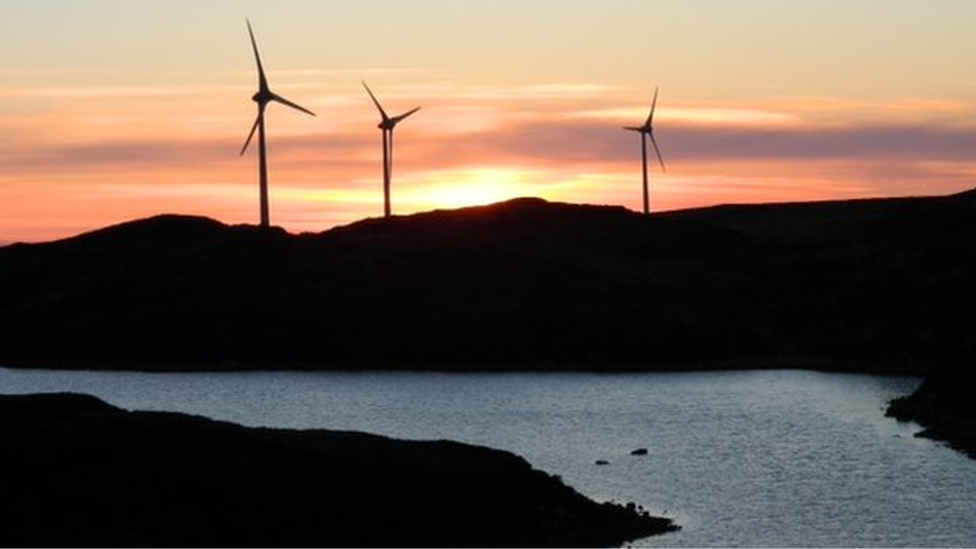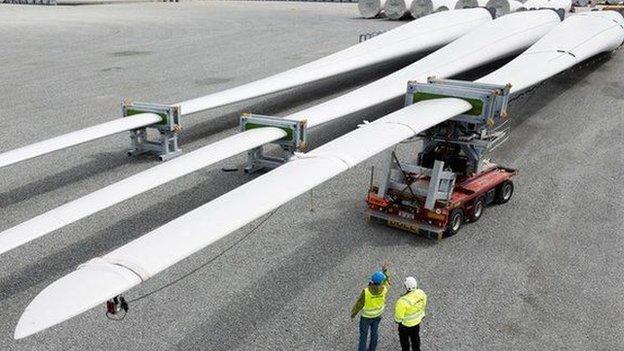Job hopes blown on the wind
- Published

Once upon a time, there were high hopes of Scotland becoming an industrial powerhouse for renewable energy.
You may recall the "Saudi Arabia of renewables" rhetoric. Land was earmarked for Dundee and Leith and Renfrew and Methil. Thousands of jobs were attached to the announcements.
It's not turning out that way. And the announcement that two of the biggest players are joining forces - Siemens and Gamesa - makes it even less likely.
So what's going on, and what's gone wrong for Scotland's plans?
Part of the story was that Carbon Capture and Storage (CCS) would be pioneered in the North Sea, treating the emissions from power stations at either Longannet or Peterhead.
They were in a competition for £1bn of UK government funding to make Britain a centre for that new technology. But the funding has been withdrawn. Both projects have been ended. The chances of Britain pioneering CCS now look very slim.
Blade building
The wind business has picked up though, at least onshore, helping Scotland to reach its ambitious emission targets for the first time.
And how many of the turbines sprouting around Scotland are made in this country, generating jobs as well as power? Of the larger turbines, only a few, from the small manufacturing plant at Campbeltown.
That has seen some rocky times financially. Bailed out by SSE and Highlands and Islands Enterprise, they sold it in April to a Korean firm, at which point it was employing 134 people.
Other turbines are imported from the countries which got ahead in the early days of turbine manufacturing - Denmark, Spain and Germany.
And with Britain having the most ambitious offshore wind plans of any country, the German bosses at Siemens agreed to put a manufacturing plant on this side of the North Sea.

The Siemens facility in Hull will manufacture 75m-long rotor blades
Including improvements to the port of Hull, the investment is of £350m, with 200 jobs in construction and 1,000 in the factory. It is due to open on 1 September this year.
The plans in Scotland have withered. In 2010, Mitsubishi took over Artemis hydraulic power pioneers near Edinburgh, with talk of £100m investment on the way.
The then first Minister, Alex Salmond, said back then: "The decision will create 30 high-quality jobs, safeguard 25 jobs and is likely to create 200 jobs by 2015. And as well as delivering new jobs and investment, over the long-term this announcement could result in the creation of a major offshore wind turbine manufacturing site in Scotland."
Artemis now has a team of about 50, and Mitsubishi has a test centre at Hunterston in North Ayrshire.
Doosan, based in Korea, announced £170m of investment, and design of a new, very large turbine - perhaps in Renfrew, perhaps Dundee. Over ten years, more than 800 new jobs were foreseen.
That was in March 2011. (The proximity to that year's election was surely coincidental, wasn't it?)
The following, December, they pulled out of the plan. Not only had they under-estimated the difficulty of getting into the market, but they hadn't reckoned on Britain's unpredictable regulatory regime.
In February 2012, GE Energy pulled out of plans for a British manufacturing facility.
Overlap
The next month, Gamesa announced it had chosen Leith over Hartlepool and Dundee as the location for its British turbine-making factory. The announcement came with the prospect of 800 jobs, and lots more indirectly, along with £125m of investment.
This was "conditional upon development of offshore wind projects in the area, securing government support and the availability of sites for prototypes". These have turned out to be significant conditions.
The following December, it was French firm Areva announcing plans to locate a manufacturing plant in Scotland, for nacelle gear casing and for turbine blades. That would have brought 750 jobs.
But then, Gamesa and Areva joined forces on developing wind turbine technology, creating a company called Adwen. They were no longer likely to build two plants in Scotland. And so far, they haven't built one.
This is what they said when they joined forces: "The company will fulfil industrial commitments engaged by Areva and Gamesa, in France and in the UK, comprising the creation of factories in Le Havre and the implementation of a network of suppliers and partners throughout the country."
And now that Gamesa and Siemens are getting together, they are looking for €230m of savings from overlapping operations.

Liberty Capital has taken over Lanarkshire's mothballed steel plants
So far, the hopes for manufacturing turbines have come to very little. There are a modest number of higher-skill jobs in designing and in managing the portfolio of wind turbines.
Scottish Power, part of Iberdrola, manages its worldwide offshore wind arrays from Glasgow.
Gamesa opened a centre for wind turbine design at Bellshill in Lanarkshire, and a management centre in Cumbernauld. The new joint venture may wish to take a look at their overlap with Siemens.
Siemens has a small service centre in Livingston, to look after its turbines throughout Scotland. And as it claims that its technology generates around half the wind power in Scotland, that means a lot of turbines.
So far, the hopes of manufacturing have come to not much at all. Some jobs have been sustained in Fife and Stornoway, building the platforms on which offshore turbines stand.
A significant order has just been confirmed for BiFab, owner of the yards, to supply the huge Beatrice wind farm development in the Moray Firth.
Then there's Liberty Capital, new owners of Lanarkshire's mothballed steel plants. Once fired up again, it is targeting its output at fabrication work for all those offshore wind turbines.
That would clearly be welcome, if it happens. But with recent experience triumphing over hype and hope, it might be wise to remain at least a little sceptical.